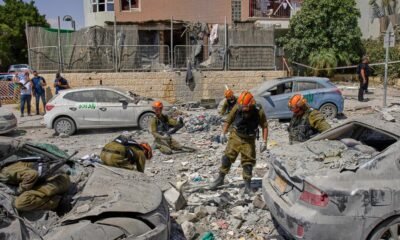cct-tracking
Three Israeli Hostages Return Home as Fragile Ceasefire Takes Its First Steps

A fragile ceasefire between Israel and Hamas has commenced, marking the beginning of what officials hope will lead to a long-awaited resolution to the ongoing conflict. This initial six-week phase aims to facilitate the release of hostages held by militants and a significant number of Palestinian prisoners.
On the first day of the ceasefire, three hostages—Romi Gonen, Emily Damari, and Doron Steinbrecher—were safely transferred to Israel after being held in Gaza. Gonen, 24, was abducted during the Nova music festival, while Damari, 28, and Steinbrecher, 31, were taken from Kibbutz Kfar Aza. Their release is the first of a planned gradual release of hostages over the coming weeks.
As part of the agreement, Israel is set to free approximately 90 Palestinian prisoners later today. In return, nearly 2,000 Palestinian detainees will be released over the truce’s duration. The Israeli military indicated that the released hostages would receive medical evaluations shortly after their arrival.
The ceasefire, effective at 11:15 a.m. local time, marks a critical juncture following 15 months of conflict, which began with a violent escalation initiated by Hamas on October 7, 2023. Initial celebrations erupted across Israel as news of the hostages’ release spread, showcasing the public’s desire for a resolution.
Despite the auspicious start, the truce faced immediate challenges. A last-minute delay initiated by Hamas prompted concerns over its durability. Notably, Israeli fire in Gaza prior to the ceasefire resulted in casualties, highlighting the underlying tensions still at play.
Israeli Defense Minister Itamar Ben-Gvir announced his party’s withdrawal from the government, reflecting internal strife regarding the ceasefire. While this move complicates Prime Minister Benjamin Netanyahu’s coalition, it does not directly hinder the new agreement.
Negotiations leading to the ceasefire were mediated by the United States, Qatar, and Egypt. The first phase, expected to bring about an exchange of hostages and prisoners by the end of the initial six weeks, is viewed as a pivotal step toward ending hostilities.
Humanitarian efforts are set to increase as well, with hundreds of aid trucks expected to enter Gaza. This surge in supplies comes after months of blocked assistance, granting relief to a population severely impacted by the extended violence.
Yet, the humanitarian toll of the conflict remains staggering. Reports indicate over 46,000 Palestinians have died, with numerous structures and infrastructure reduced to rubble. In stark contrast, the civilian casualties in Israel from the initial Hamas attacks were also substantial, prompting this prolonged clash.
As the situation develops, questions abound regarding the future: Will the ceasefire hold? How will the remaining hostages be handled? The world watches closely, hopeful for stability yet wary of the complexities that remain.


















